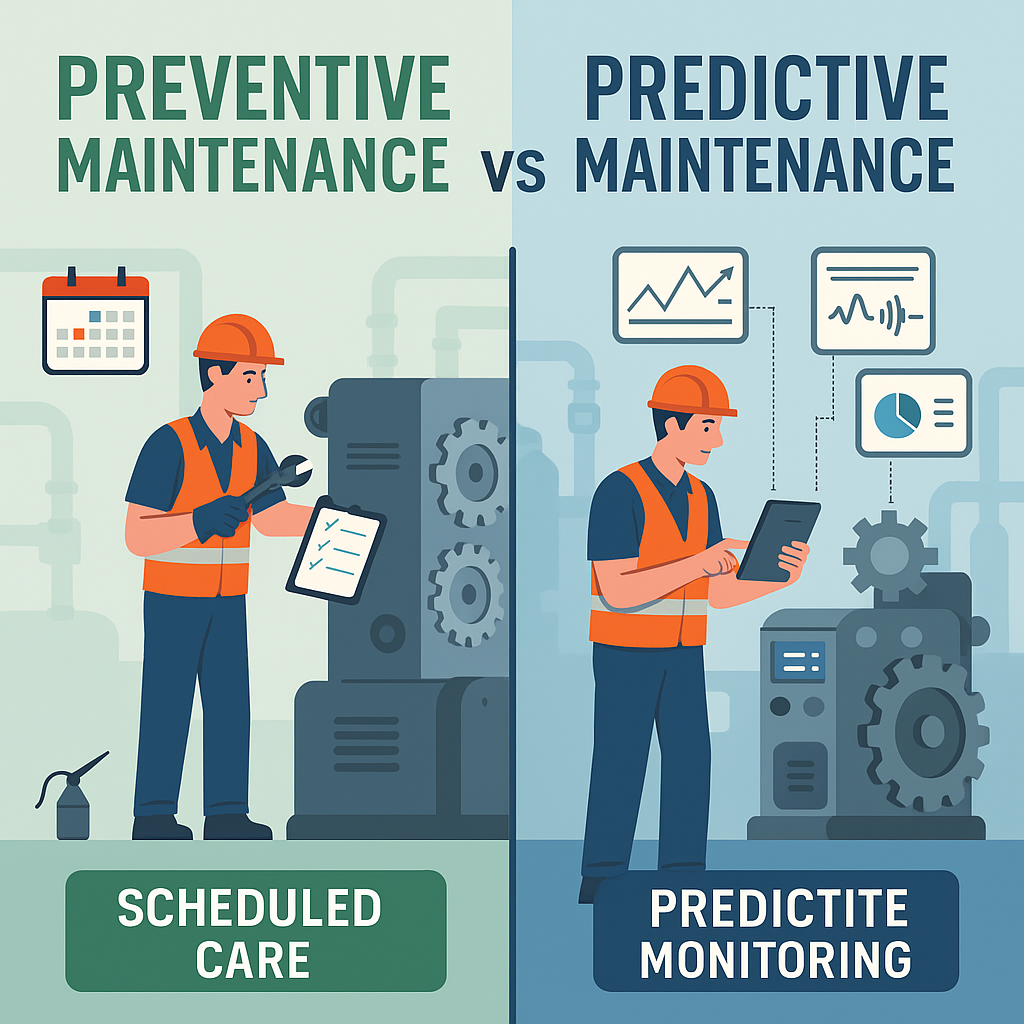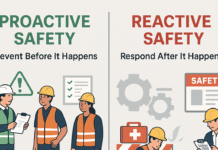
Preventive Maintenance vs Predictive Maintenance
When it comes to maintaining workplace equipment and ensuring operational safety, two popular strategies often come into play — Preventive Maintenance and Predictive Maintenance.
Although both aim to reduce downtime, prevent equipment failure, and enhance safety, they use very different approaches to achieve these goals.
In this guide, we’ll explore the key differences between preventive and predictive maintenance, their advantages, and how to choose the right one for your organization.
What is Preventive Maintenance (PM)?
Definition
Preventive Maintenance is a scheduled, routine maintenance activity carried out at regular intervals — regardless of the equipment’s current condition.
Its goal is to prevent failures before they happen by replacing or servicing components based on a fixed schedule.
Purpose
- To minimize unexpected breakdowns.
- To extend equipment lifespan.
- To ensure safe and reliable operation.
- To reduce long-term repair costs.
How It Works
Maintenance tasks are performed based on time intervals or usage metrics, such as:
- Every 3 months or 500 operating hours.
- Based on manufacturer’s recommendations or maintenance checklists.
For example, changing oil in a generator every 100 hours — even if it still looks clean.
Examples of Preventive Maintenance
- Replacing filters every 30 days.
- Lubricating moving parts monthly.
- Inspecting fire extinguishers quarterly.
- Servicing HVAC systems every 6 months.
- Checking machine belts and bearings weekly.
Industries That Commonly Use PM
- Manufacturing and production.
- Facility management.
- Healthcare (equipment calibration).
- Construction (cranes, forklifts).
- Power plants and utilities.
What is Predictive Maintenance (PdM)?
Definition
Predictive Maintenance is a data-driven approach that monitors equipment condition in real-time to predict when maintenance should be performed.
Instead of using a fixed schedule, predictive maintenance uses sensors, IoT devices, and analytics to detect early signs of wear, vibration, temperature rise, or noise.
Purpose
- To detect potential failures before they occur.
- To minimize unplanned downtime.
- To reduce unnecessary maintenance activities.
- To optimize asset performance and extend equipment life.
How It Works
Sensors and monitoring systems continuously track equipment parameters such as:
- Vibration levels.
- Oil condition and temperature.
- Pressure and flow rates.
- Acoustic or ultrasonic signals.
When readings deviate from normal limits, the system alerts maintenance teams to take corrective action before failure.
Examples of Predictive Maintenance
- Using vibration sensors to predict bearing failure in motors.
- Monitoring oil viscosity to plan engine servicing.
- Detecting temperature rise in electrical panels.
- Using thermal imaging to spot overheating components.
- Applying AI algorithms to forecast breakdown trends.
Industries That Use PdM
- Oil and gas.
- Aerospace.
- Automotive manufacturing.
- Power generation.
- Smart factories using Industry 4.0 technologies.
Key Differences Between Preventive and Predictive Maintenance
| Aspect | Preventive Maintenance (PM) | Predictive Maintenance (PdM) |
|---|---|---|
| Approach | Time-based or schedule-based | Condition-based or data-driven |
| Timing | Performed at fixed intervals | Performed when indicators show risk of failure |
| Focus | Prevention through routine service | Prediction through real-time monitoring |
| Technology Requirement | Low – manual or basic tools | High – sensors, IoT, data analytics |
| Cost | Lower initial cost, higher long-term cost | Higher setup cost, lower operational cost |
| Efficiency | May result in unnecessary maintenance | Highly efficient and optimized |
| Downtime | Planned but may be frequent | Reduced and targeted |
| Examples | Oil change every 3 months | Oil change only when viscosity drops |
| Data Dependency | Minimal | High – relies on continuous data |
| Ideal For | Small to medium industries | Large or technology-driven industries |
How Preventive and Predictive Maintenance Work Together
While both methods differ in approach, the best maintenance strategy combines both for maximum efficiency.
Example:
- A factory schedules preventive maintenance for monthly visual inspections.
- At the same time, it uses predictive sensors to detect vibration anomalies.
If sensors detect abnormal vibration between inspections, a maintenance alert is triggered — avoiding a breakdown between scheduled intervals.
This hybrid system is often called Condition-Based Maintenance (CBM).
Advantages of Preventive Maintenance
- Simple to implement.
- No complex technology required.
- Predictable schedules.
- Easy to plan manpower and spare parts.
- Reduced breakdowns.
- Regular inspections catch early wear.
- Improved equipment life.
- Consistent care extends lifespan.
- Lower safety risks.
- Prevents failures that could cause accidents.
Disadvantages
- May result in over-maintenance.
- Doesn’t consider actual equipment condition.
- Labor-intensive and costly in long term.
Advantages of Predictive Maintenance
- Minimized downtime.
- Maintenance only when needed.
- Cost efficiency.
- Reduces unnecessary part replacements.
- Increased reliability.
- Detects issues before failure.
- Data-driven insights.
- Supports decision-making with accurate data.
- Enhanced safety.
- Identifies hazards in advance through monitoring.
Disadvantages
- High initial investment for sensors and analytics.
- Requires technical expertise to interpret data.
- Dependent on technology reliability.
Examples in Industrial Settings
1. Electrical Maintenance
- Preventive: Inspect switchgear monthly and tighten terminals.
- Predictive: Use thermal imaging to detect overheating before failure.
2. Machinery Maintenance
- Preventive: Lubricate machine bearings every 200 hours.
- Predictive: Use vibration analysis to replace bearings only when wear is detected.
3. Vehicle Maintenance
- Preventive: Replace brake pads every 10,000 km.
- Predictive: Replace when brake wear sensors indicate remaining thickness.
When to Use Preventive vs Predictive Maintenance
| Condition | Best Option |
|---|---|
| Limited budget, smaller setup | Preventive Maintenance |
| High-value, critical assets | Predictive Maintenance |
| No monitoring technology available | Preventive Maintenance |
| Data collection and analysis systems installed | Predictive Maintenance |
| Desire for simple scheduling | Preventive Maintenance |
| Focus on long-term optimization | Predictive Maintenance |
How to Transition from Preventive to Predictive Maintenance
- Start by tracking data — use CMMS (Computerized Maintenance Management Systems).
- Install sensors for vibration, temperature, or pressure monitoring.
- Train maintenance teams on data interpretation and response.
- Integrate predictive tools with preventive schedules.
- Review and adjust strategies based on performance data.
This step-by-step approach ensures a smooth transition without disrupting operations.
Summary Table: Preventive vs Predictive Maintenance
| Feature | Preventive Maintenance | Predictive Maintenance |
|---|---|---|
| Definition | Maintenance at set intervals | Maintenance based on real-time data |
| Main Goal | Prevent failure | Predict failure |
| Trigger | Calendar or usage hours | Sensor alerts or data trends |
| Technology | Low-tech | High-tech |
| Initial Cost | Low | High |
| Operational Cost | Higher over time | Lower over time |
| Best For | Routine equipment | Critical or high-cost assets |
Conclusion
In essence, preventive maintenance helps you stay ahead of failures through regular schedules, while predictive maintenance helps you act precisely when a failure is imminent.
Both methods aim to ensure equipment reliability and worker safety — but predictive maintenance provides a smarter, data-driven advantage for modern industries.
“Preventive maintenance is about routine care; predictive maintenance is about intelligent care.”
By integrating both, organizations can reduce downtime, enhance safety, and achieve long-term operational excellence.
For more checklist and templates visit: The HSE Tools.
Proactive Safety vs Reactive Safety
What are the 7 Steps of Safety?
Static Electricity Hazards in the Workplace
How to Conduct a Fire Drill: Step-by-Step Safety Officer Guide
FAQs
Q1. Which maintenance approach saves more money in the long run?
Predictive maintenance generally saves more by reducing unnecessary servicing and preventing catastrophic failures.
Q2. Is preventive maintenance still relevant in smart factories?
Yes. Even with predictive tools, scheduled maintenance ensures compliance and baseline safety checks.
Q3. What tools are used in predictive maintenance?
IoT sensors, vibration analyzers, thermal cameras, ultrasound detectors, and CMMS software.
Q4. Which one improves equipment lifespan more effectively?
Predictive maintenance, since interventions happen only when the system truly needs them.
Q5. Can both methods be used together?
Absolutely. Combining preventive and predictive strategies creates a balanced, cost-effective maintenance system.
























